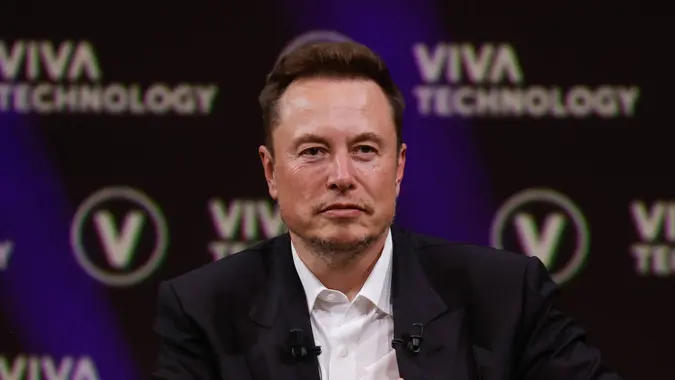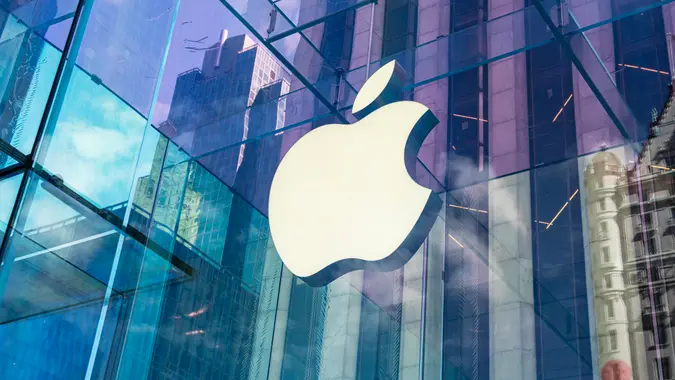Nvidia Just Beat Apple in This Crazy Metric — Should You Buy the Stock?

Commitment to Our Readers
GOBankingRates' editorial team is committed to bringing you unbiased reviews and information. We use data-driven methodologies to evaluate financial products and services - our reviews and ratings are not influenced by advertisers. You can read more about our editorial guidelines and our products and services review methodology.

20 Years
Helping You Live Richer

Reviewed
by Experts

Trusted by
Millions of Readers
When you think about valuable companies, you probably think about their market cap. But there’s a wild metric that reveals something much more interesting: market capitalization per employee. And Nvidia just absolutely crushed Apple in this bizarre measurement that might actually matter more than you think.
Here’s the comparison: Nvidia’s market cap per employee stands at over $90 million per worker. Apple? Just $18 million per employee. Microsoft comes in at $15 million per employee. That means each Nvidia employee is “worth” five times more than an Apple employee from a market valuation perspective.
Nvidia vs. Apple: The Shocking Per-Employee Value Comparison
Let’s break down what we’re actually looking at here. Nvidia currently sits at a $4.2 trillion market cap with just 36,000 employees. Do the math and you get roughly $117 million per employee at today’s stock price of around $172.
Apple, despite being worth slightly less at around $3.3 trillion, employs about 180,000 people worldwide. That works out to roughly $18 million per employee. It’s still an incredible number, but nothing compared to Nvidia’s productivity machine.
You might be thinking, “This is just a fun math exercise,” but market cap per employee reveals something crucial about how modern businesses create value. Companies with high per-employee valuations typically share certain characteristics that make them incredibly attractive investments.
First, they’re usually asset-light businesses that rely heavily on intellectual property rather than physical infrastructure. Nvidia doesn’t manufacture its own chips. Instead, it designs them and outsources production to companies like Taiwan Semiconductor. This means they can scale revenue without proportionally scaling their workforce.
Why Market Cap Per Employee Matters for Stock Investors
Second, these companies often operate in markets with massive demand but limited competition. Nvidia essentially has a monopoly on the AI chip market right now, powering everything from ChatGPT to self-driving cars. When you’re the only game in town for the most important technology trend of our time, you can charge premium prices.
Third, high per-employee value companies benefit from network effects and scalability. Once Nvidia develops a new chip architecture, that intellectual property can generate billions in revenue without requiring thousands of additional employees.
What History Tells Us About Nvidia Stock
Other companies have achieved high per-employee values during commodity booms. Oil company Amoco reached extreme valuations per worker in the late 1970s when oil prices skyrocketed. But those valuations proved temporary when commodity prices normalized.
The question is whether Nvidia’s AI boom represents a sustainable transformation or another bubble waiting to pop.
Should You Buy Nvidia Stock? The Investment Case
So should you buy Nvidia stock based on this metric? The answer depends on what you believe about the durability of the AI boom.
The bull case is compelling: AI is still in its early innings, and Nvidia has built an almost insurmountable moat around its technology. The company’s chips don’t just process AI workloads — they’ve become the standard that entire ecosystems are built around. Switching costs are enormous, and Nvidia continues to innovate faster than competitors can catch up.
Revenue growth supports the valuation story. Nvidia’s sales increased 69% year-over-year (YOY) in its most recent quarter, reaching $44.1 billion. Net income was nearly $18.8 billion, up 26% from the previous year. These aren’t bubble metrics; they represent real business performance.
The bear case centers on sustainability and competition. Every tech giant is trying to reduce dependence on Nvidia chips. Apple designs its own processors, Google has its Tensor Processing Units and even OpenAI is reportedly developing custom chips. If major customers start replacing Nvidia chips with in-house alternatives, that $90 million per-employee valuation could crash quickly.
There’s also the regulatory risk. Nvidia’s dominance has attracted antitrust attention, and any restrictions on the company’s business practices could impact profitability.
Nvidia Stock Analysis: Risk vs. Reward for 2025
Nvidia’s wildly high per-employee numbers tell us two important things: intellectual property is incredibly powerful, but putting all your eggs in one basket is risky.
Think about it this way. If you’re a growth investor, Nvidia looks amazing. The company can sell its chip designs all over the world without hiring thousands more people. But if you’re a value investor, those same numbers are scary. When each employee is theoretically “worth” $90 million, the company has to be nearly perfect. There’s no room for mistakes or disappointing earnings.
So what should you actually do? The smart move is probably to own some Nvidia stock if you’re investing in tech, but don’t make it your entire portfolio. History teaches us that companies with these extreme valuations can make you rich — or they can crash hard when things change. Remember, buying Nvidia isn’t just buying a stock. You’re betting that AI will keep growing and that Nvidia will stay ahead of competitors like Apple and Google who are trying to build their own chips.
That’s probably a good bet given how fast AI is growing. Just don’t risk money you can’t afford to lose.
 Written by
Written by  Edited by
Edited by 

























